It is now 12 years since the Grape Growers Council and the Wine Institute merged but the time may be ripe for New Zealand Winegrowers to become the sole entity.
You can be forgiven for thinking that it already is, given NZW oversees all issues relating to growers and wineries. The truth of the matter is though, that the Grape Growers Council and the Wine Institute are still legal bodies, that feed into NZW.
Chairman of the Board, Steve Green says currently NZW is an unincorporated society, without any power of its own.
“It has no legal entity and no legal identity. We want to give the members the opportunity to consider dissolving the two existing organisations, (Grape Growers and Wine Institute) and merge into a single one.”
Green says currently NZW has no financial accountability. That role flows back to members via the two separate arms of the organisation.
Board Deputy Chair and Chair of the Grape Growers Council, John Clarke says there was always the intention to bring the two organisations into one, when NZW was formed in 2002.
“But they didn’t want to take that step straight away, instead they went with a memorandum of understanding (MOU). So 12 years down the track, we still have that and it is working. But we could formalise it and we should for all the reasons Steve has talked about.”
In terms of financial accountability, both organisations currently levy their members separate of each other. While those two streams of funding go into one pool overseen by NZW, the reporting back to members is separated out. Growers receive one set of accounts, Wine Institute members receive another.
There is no overall picture of how much NZW has spent as a group.
“If you are not a member of both organisations, you only get half the story,” Green says.
“But the key point we want to make, is this is a process of consultation, first and foremost.”
There is no pre-conceived idea of how any new structure would look, Green says, as it has to be up to members not the board itself.
“At the end of the day, it will be the members who will make the decision, it will not be the board.”
Meetings were held around the country in September, (just as NZWinegrower was going to print) with members encouraged to provide feedback. And this is no quick fire decision making process either. Any new structure is unlikely to be in place for 12 to 15 months.
“We will back up our public meetings with some pretty extensive information on the website, and we want to hear from as many members as possible,” Clarke says.
“After the public meetings we will call for written submissions. We hope to get those from companies, individuals and regional associations,” Green added. “Then having received those, we will ask if anyone wants to be heard. The sub committee will come round to hear those, and then we will report back to the board and the board will come back to members with a formal proposal. Then there will be another process in terms of ratification.”
While the processes are quite involved, Clarke says the end result is unlikely to even be noticed by those outside the industry.
“Anybody who deals with NZW, whether that be in a marketing sense or whatever, won’t see any difference.”
The governance issue was highlighted back in 2011, when PwC undertook a review of NZW.
Clarke says basically “this is unfinished business and the board has spent a lot of time and energy developing some options about the future shape of the organisation.”
Both men say it is important members educate themselves about the options, so when the time comes they can make a well-informed decision.
This email address is being protected from spambots. You need JavaScript enabled to view it.




